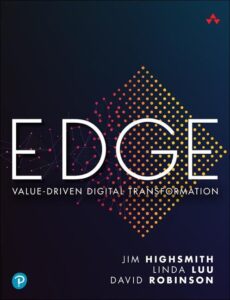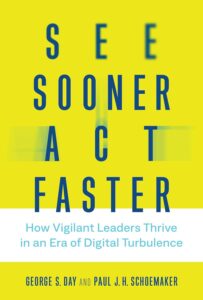The buzz words “digital transformation” may be overused, but that doesn’t make them less meaningful. If anything, digital transformation is more relevant then ever, but organizations continue to struggle, first, with how they define digital transformation, and second, how to initiate a successful digital transformation.
We witness this struggle every day and work with our clients to successfully define, assess, plan and execute successful technology initiatives that enable them to run their organizations more efficiently and effectively.
One thing that makes the process smoother is when all the stakeholders of a digital transformation initiative are communicating from a shared vision and understanding. We’ve listed five books below that can help lay the groundwork for both.
1. Designed for Digital: How to Architect Your Business for Sustained Success by Jeanne w. Ross
DESCRIPTION:
Practical advice for redesigning “big, old” companies for digital success, with examples from Amazon, BNY Mellon, LEGO, Philips, USAA, and many other global organizations.

Designed for Digital offers practical advice on digital transformation, with examples that include Amazon, BNY Mellon, DBS Bank, LEGO, Philips, Schneider Electric, USAA, and many other global organizations. Drawing on five years of research and in-depth case studies, the book is an essential guide for companies that want to disrupt rather than be disrupted in the new digital landscape.
Five Building Blocks of Digital Business Success
1. Shared Customer Insights
2. Operational Backbone
3. Digital Platform
4. Accountability Framework
5. External Developer Platform
2. Implementing World-class IT Strategy: How it Can Drive Organizational Innovation by Peter High
DESCRIPTION:
The actionable guide for driving organizational innovation through better IT strategy.

High makes use of case examples from leading companies to illustrate the various ways that IT infrastructure strategy can be developed, not just to fall in line with business strategy, but to actually drive that strategy in a meaningful way. His ideas are designed to provide real, actionable steps for CIOs that both increase the executive’s value to the organization and unite business and IT in a manner that produces highly-successful outcomes.
· Formulate clearer and better IT strategic plans
· Weave IT strategy into business strategy at the corporate and business unit levels
· Craft an infrastructure that aligns with C-suite strategy
· Close the gap that exists between IT leaders and business leaders
While function, innovation, and design remain key elements to the development and management of IT infrastructure and operations, CIOs must now think beyond their primary purview and recognize the value their strategies and initiatives will create for the organization. With Implementing World Class IT Strategy, the roadmap to strategic IT excellence awaits.
3. EDGE: Value-Driven Digital Transformation by Jim Highsmith, Linda Luu and David Robinson
DESCRIPTION:
The Agile Operating Model That Will Help You Successfully Execute Your Digital Transformation

Jim Highsmith is one of the world’s leading agile pioneers and a coauthor of the Agile Manifesto. He, Linda Luu, and David Robinson know from their vast in-the-trenches experience that sustainable digital transformation requires far more than adopting isolated agile practices or conventional portfolio management. This hard, indispensable work involves changing culture and mindset, and going beyond transforming the IT department. EDGE embraces an adaptive mindset in the face of market uncertainty, a visible, value-centered portfolio approach that encourages continual value linkages from vision to detailed initiatives, incremental funding that shifts as strategies evolve, collaborative decision-making, and better risk mitigation. This guide shows leaders how to use the breakthrough EDGE approach to go beyond incremental improvement in a world of exponential opportunities.
· Build an organization that adapts fast enough to thrive
· Clear away unnecessary governance processes, obsolete “command and control”
leadership approaches, and slow budgeting/planning cycles
· Improve collaboration when major, fast-paced responses are necessary
· Continually optimize investment allocation and monitoring based on your vision and goals
4. See Sooner, Act Faster: How Vigilant Leaders Thrive in an Era of Digital Turbulence (Management on the Cutting Edge) by George S. Day and Paul J.H. Schoemaker
DESCRIPTION:
How organizations can anticipate threats, spot opportunities, and act faster when the time is right; with rich examples including Adobe, MasterCard, and Amazon.

Vigilant firms have greater foresight than their rivals, while vulnerable firms often miss early signals of external threats and organizational challenges. Charles Schwab, for example, was early to see and act on the promise of “robo-advisors”; Honeywell, on the other hand, stumbled when Nest Labs came out first with a “smart” thermostat. Day and Schoemaker show leaders how to assess their vigilance capabilities and cultivate insight and foresight throughout their organizations. They draw on a range of cases, including Adobe and Intuit’s move to the cloud, Shell’s investment in clean energy, and MasterCard’s early recognition of digital challenges.
Day and Schoemaker describe how to allocate the scarce resource of attention, how to detect weak signals and separate them from background noise, and how to respond strategically before competitors do. The challenge is not just to act faster but to act wisely, and the authors suggest ways to create dynamic portfolios of options. Finally, they offer an action agenda, with tips for fostering vigilance and agility throughout an organization. The rewards are stronger market positions, higher profits and growth, more motivated employees, and organization longevity.
5. Digital Transformation: Survive and Thrive in an Era of Mass Extinction by Thomas M. Siebel
DESCRIPTION:

